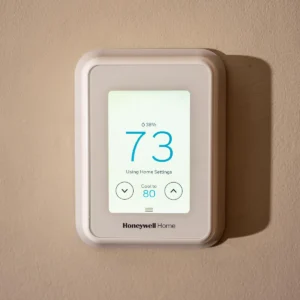Smart thermostats represent a leap in home heating and cooling technology that gives the homeowner supreme control over their indoor climate. Recently, with the surge in demand for green energy solutions, smart thermostats for able air conditioning and heating systems have come to the limelight. The following guide takes a closer look at the world of the smart thermostat: advantages, working principles, and reasons for considering this important upgrade for any modern home.
What is a Smart Thermostat?
More than just being a temperature control unit, a smart thermostat learns your lifestyle, adjusts itself to your schedule, and is remotely controlled from your smartphone, tablet, or a voice assistant device. This section takes a closer look at the core features of smart thermostats and at just how seamlessly these units find themselves a place within your home’s HVAC system.
Benefits of Installing a Smart Thermostat
Energy Efficiency and Cost Savings
One of the key advantages of smart thermostats is their capability to minimize energy use, which directly translates into cost savings on utility bills. With smart optimization in heating and cooling schedules, energy is being used only when required.
Enhanced Comfort and Convenience
Smart thermostats, meanwhile, adjust room temperatures in accordance with one’s daily schedule and preferences, maintaining an ideal environment without necessarily wasting energy on an empty house. Plus, with remote access, you always come back to a perfectly cooled or heated house.
Detailed Energy Usage Reports
Most of the smart thermostats give insight into the detailed patterns of how one uses their energy, often coming with comprehensive reports that help you understand your consumption and find ways to optimize it even better.
The Top Smart Thermostats on the Market
Reviewing Leading Models
This section compares several top-rated smart thermostats, highlighting their features, compatibility with various HVAC systems, and user reviews. From Nest to Ecobee, and Honeywell, find out which models offer the best performance for able air conditioning and heating systems.
Nest Learning Thermostat:
- The Nest is known for its “learning” capability, which automatically adjusts the thermostat based on your habits and schedule. This feature is ideal for those who prefer a set-it-and-forget-it approach.
- Its sleek design with a stainless steel ring allows it to blend into home decor by reflecting the wall’s color. However, it lacks a touchscreen, using a scrolling ring for control instead, which reduces fingerprints but might complicate interaction for some users.
- It supports voice control through Google Home and Amazon Alexa but not Apple HomeKit, which might be a downside for Apple users.
- Nest claims to save 10-12% on heating bills and 15% on cooling bills
Ecobee Smart Thermostat:
- Ecobee excels in detailed energy tracking with its Home IQ feature and offers robust smart home integration, supporting Google Assistant, Amazon Alexa, and Apple HomeKit. This makes it a versatile choice for users integrated into various smart home ecosystems.
- It includes a built-in Alexa speaker, eliminating the need for a separate smart speaker for voice control.
- Ecobee’s touchscreen interface provides ease of use and direct control at the device itself.
- It claims to save up to 23% on heating and cooling costs, making it potentially the most energy-efficient option among the three
Honeywell Home T9:
- The Honeywell Home T9 is appreciated for its compatibility with a variety of HVAC systems and its effective room sensors that adjust the system based on movement in different rooms.
- It features a touchscreen that, while user-friendly, may show fingerprints.
- It supports Google Assistant and Amazon Alexa, but its smart home integration is not as extensive as Ecobee’s.
- The energy efficiency of Honeywell thermostats is highly regarded, with features like Smart Response Technology that learns your heating and cooling cycle times to optimize energy use.
Troubleshooting Common Issues
Handling Connectivity and Performance Problems
Even the most advanced technology can encounter issues. This section addresses common troubleshooting scenarios for smart thermostats, offering practical tips on resolving connectivity problems, calibration issues, and software glitches.
When troubleshooting a smart thermostat that isn’t working properly, here are the top three points to check:
- Power Issues: Ensure the thermostat is receiving power. This can involve checking for a tripped circuit breaker, ensuring the wiring is properly connected, and verifying that batteries (if used) are not dead. It’s also worth checking whether the thermostat’s display is on and responsive. If the display is blank or unresponsive, a power issue is likely.
- Network Connectivity: Smart thermostats need a stable Wi-Fi connection to function optimally. Check if the thermostat is connected to the Wi-Fi network and if the network is active. You can try resetting your router or moving it closer to the thermostat to improve signal strength. Additionally, verify that the thermostat’s firmware is up to date, as outdated firmware can cause connectivity issues.
- Settings and Configuration: Incorrect settings can prevent a thermostat from operating correctly. Check the thermostat settings to ensure they are correct for your needs, including schedules, heating and cooling set points, and any special modes. It’s also useful to check if the thermostat is calibrated correctly and if there are any error codes displayed that can guide further diagnostics.
These steps can resolve many common issues with smart thermostats. If problems persist after these checks, consulting the manufacturer’s support or a professional technician might be necessary.
Smart thermostats are far beyond just a device used to control the indoor temperature in your home; they are part of a modern, energy-efficient home. By selecting the right smart thermostat for your capable air conditioning and heating system, you stand to gain comfort, lower energy bills, and improvement in quality of life.



















